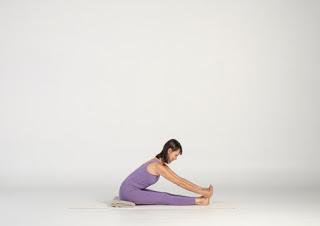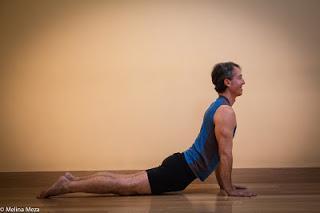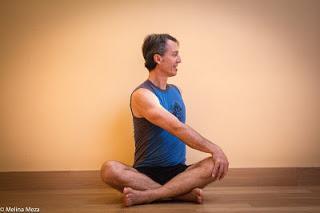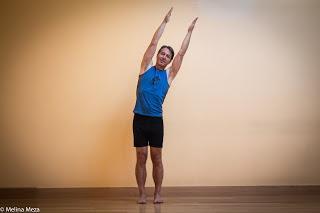A: This is a great question and one that received at a recent workshop on healthy aging, where I was peppered with questions about how to practice yoga poses when you have osteoporosis or osteopenia (thinning of the bones), specifically in the spine. In that workshop, I did my best to provide some general guidelines on how to practice different poses, what to include, and what to avoid. But it left me wanting to get clearer myself on some basic guidelines on how to approach this increasingly common condition in our aging population.
As we have reported previously, those with thinning of the bones are at increased risk of fractures to their bones as they age, especially if they fall. Of the bones that can and do break, the bones of the spinal column, and the thoracic vertebrae in particular, are the most commonly fractured. The front part of the vertebrae often collapses on itself, creating a wedge shape to the bone, which can in some cases contribute to kyphosis or forward rounding of the spine. Most commonly, when a wedge fracture occurs, it only affects just one vertebra, usually in the lower thoracic spine. However, your first wedge fracture increases your chances of getting a second one. There have been some studies on how common these fractures are, and the prevalence is said to be around 20% in men and women over the age of 70, and the incidence increases with age in both men and women. Although not all vertebral fractures result in symptoms, many affected people do experience pain, disability, and an increase in morbidity and mortality, the opposite of our hopes for those practicing yoga for healthy aging.
However, if your bones have thinned to the point of osteoporosis or osteopenia, greater caution is recommended. Eva Norlyk Smith, PhD, of YogaUonline her colleague Anita Boser did a wonderful review of the literature in 2013 to get just the answers my students were looking for. Their recommendations fit nicely with what I usually suggest for my students.
Here is a list of ways to work with asana:
1. Forward bending of the spine (flexion), as in seated and standing forward bends, puts the vertebrae at greater risk of wedge fractures, and the research on this is pretty strong. So teaching yourself or your students to only tip forward from the hip joints while keeping the spine straight is key to doing these poses safely (if you decide to keep them in your practice). This can be challenging to understand clearly (and feel from the inside) so it is a good idea to get some feedback from your teacher on whether you are doing this correctly. And doing supine poses for stretching, such as Reclined Leg Stretch, are great ways of stretching tight hamstrings and gluteal muscles without threatening the vertebrae. This is particularly important for people who have severe kyphosis of the thoracic spine (with no fractures) for whom any poses that potentially take the spine into any forward bending (flexion) are not recommended.
 2. Back bending poses that take the spine into extension are considered generally safe, and both strengthen muscles and stimulate the bones of the spine. This is supported by good research. These poses also promote better sitting and standing posture, which is key for maintaining overall spinal health as you age. Cobra, Locust, Warrior 1, and Bridge poses are all examples of poses that would help.
2. Back bending poses that take the spine into extension are considered generally safe, and both strengthen muscles and stimulate the bones of the spine. This is supported by good research. These poses also promote better sitting and standing posture, which is key for maintaining overall spinal health as you age. Cobra, Locust, Warrior 1, and Bridge poses are all examples of poses that would help.  3. Twisting or rotating the spine has generally been discouraged by doctors and movement specialists, mostly due to the chances of this movement causing low back pain or disc problems. However, there is no research showing it can increase vertebral fractures. And there is some early research, such as the recent study by Loren Fishman, MD that suggests that twists may actually stimulate bone strengthening. However, without a clear consensus, I recommend practicing gentle twists that do not take you to the limit of your twisting ability, and only those that are not combined with forward bending of the spine (flexion), such as One-Legged Forward Bend (Janu Sirsasana) or Revolved Triangle pose (Paravritti Tirkonasana). Easy Sitting Twist (Parvirtta Sukasana) is an example of safe pose for you.
3. Twisting or rotating the spine has generally been discouraged by doctors and movement specialists, mostly due to the chances of this movement causing low back pain or disc problems. However, there is no research showing it can increase vertebral fractures. And there is some early research, such as the recent study by Loren Fishman, MD that suggests that twists may actually stimulate bone strengthening. However, without a clear consensus, I recommend practicing gentle twists that do not take you to the limit of your twisting ability, and only those that are not combined with forward bending of the spine (flexion), such as One-Legged Forward Bend (Janu Sirsasana) or Revolved Triangle pose (Paravritti Tirkonasana). Easy Sitting Twist (Parvirtta Sukasana) is an example of safe pose for you. 4. Side bending movements have not been specifically researched, but again, I feel that doing some side bending, shy of your full range of movement seems reasonable and keeps your joints mobile in that direction. Crescent Moon pose (the side bending version of Arms Overhead pose) is a good choice.
4. Side bending movements have not been specifically researched, but again, I feel that doing some side bending, shy of your full range of movement seems reasonable and keeps your joints mobile in that direction. Crescent Moon pose (the side bending version of Arms Overhead pose) is a good choice. 5. There was a lot of interest in whether the gentle spinal movements of Cat-Cow pose are safe for those with osteoporosis. Research suggests that gentle combinations of arching and rounding like this may be beneficial. The movement is dynamic, smooth, and if not forced or aggressive, seems relatively safe and helps to maintain your range of motion in those directions. Also, if you are doing it on hands and knees, your spine is parallel to the floor so the gravitational forces on the vertebrae are reduced, theoretically making is safer.
5. There was a lot of interest in whether the gentle spinal movements of Cat-Cow pose are safe for those with osteoporosis. Research suggests that gentle combinations of arching and rounding like this may be beneficial. The movement is dynamic, smooth, and if not forced or aggressive, seems relatively safe and helps to maintain your range of motion in those directions. Also, if you are doing it on hands and knees, your spine is parallel to the floor so the gravitational forces on the vertebrae are reduced, theoretically making is safer.  And teachers out there, always keep in mind that one size does not fit all, so please take into considerations the unique combination of conditions your students have and customize your recom-mendations for each person.
And teachers out there, always keep in mind that one size does not fit all, so please take into considerations the unique combination of conditions your students have and customize your recom-mendations for each person.—Baxter
Subscribe to Yoga for Healthy Aging by Email ° Follow Yoga for Healthy Aging on Facebook ° Join this site with Google Friend Connect

